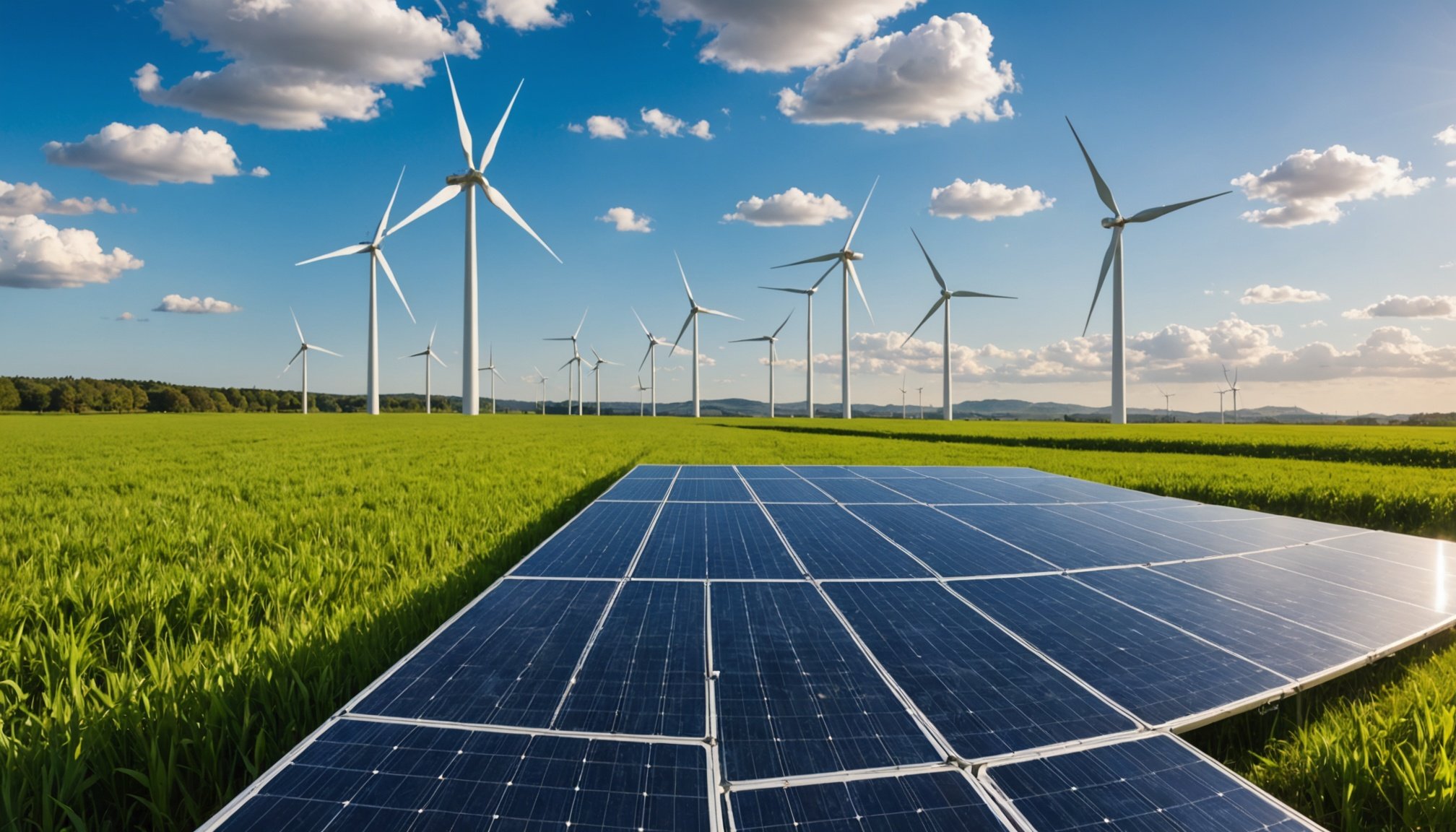Overview of AI in Renewable Energy
Artificial intelligence (AI) is revolutionising the renewable energy sector. By automating complex processes and enhancing decision-making, AI in renewable energy is setting the stage for significant advancements. Renewable energy management is increasingly relying on AI to optimise the harnessing of natural resources such as wind, solar, and hydropower. This digital transformation is driven by the need to improve efficiency and sustainability.
Artificial intelligence applications in this field cover a wide range of technologies. These include machine learning algorithms, which predict energy production patterns, and advanced analytics, which drive energy storage solutions. AI’s capability to analyse vast datasets and adapt to changing conditions means that energy systems can be more reliable and efficient.
Additional reading : Boosting AI Performance: Proven Strategies to Optimize Efficiency in IoT Networks
Integrating AI technologies into renewable energy systems is vital. This integration not only boosts performance but also enhances economic viability by reducing operational costs. The current landscape shows a growing trend towards employing AI to tackle the challenges of intermittent energy sources and fluctuating demands.
The technologies involved are as diverse as they are promising, from smart grid innovations to AI-enhanced predictive maintenance. Together, they form a dynamic ecosystem that positions renewable energy systems at the forefront of modern energy solutions. This synergy highlights the enormous potential of AI to transform how renewable energy is generated, distributed, and consumed.
Additional reading : Top strategies for leveraging product lifecycle management in cybersecurity
Benefits of AI Integration in Renewable Energy
The integration of AI in renewable energy systems offers substantial benefits, enhancing both efficiency and economic outcomes. AI-driven predictive analytics enable more accurate forecasting of energy production and consumption patterns. By applying smart algorithms, energy systems can operate optimally, thus minimizing waste and maximizing output.
One of the most compelling benefits is cost reduction. Through optimised energy distribution and usage, AI can significantly lower operational expenses. The technology ensures precise alignment of energy supply with demand, reducing excess production and associated costs. Moreover, smart grid systems powered by AI can manage load distribution intelligently, further decreasing operational inefficiencies.
The environmental impact is also noteworthy. AI contributes to sustainability by improving resource management, reducing carbon emissions, and promoting renewable energy usage. Better prediction and real-time adjustments mean less reliance on carbon-heavy alternatives, making sustainable practices more attainable.
Additionally, AI enhances decision-making processes within renewable energy management. By rapidly processing large datasets, it provides actionable insights, supporting better strategic planning. This capability ensures that energy systems are not only efficient but also resilient against external fluctuations and uncertainties.
Key benefits of AI include:
- Enhanced efficiency through predictive analytics
- Significant cost savings
- Sustainable resource management and reduced environmental impact
Applications of AI in Renewable Energy Systems
The implementation of AI applications in renewable energy systems is diverse and transformative. Within energy management systems, AI enhances efficiency and reliability by leveraging data-driven insights. These applications are crucial for optimizing operations and minimizing waste.
Predictive Maintenance
Predictive maintenance is a powerful aspect of AI in renewable energy. It enables systems to anticipate equipment failures, thereby reducing downtime. In wind and solar energy operations, predictive maintenance tools have proven invaluable. They monitor equipment status, allowing for timely interventions and extending the lifespan of assets. This proactive approach ensures minimal operational disruptions.
Optimizing Energy Distribution
AI is vital in optimizing energy distribution networks. By utilizing real-time monitoring and load balancing, AI ensures efficient energy flow. It dynamically adjusts to consumption patterns, preventing overloads and ensuring resource availability where needed. Various case studies highlight the effectiveness of AI-driven energy distribution, showcasing improvements in reliability and user satisfaction.
Smart Grid Technologies
AI-enhanced smart grid technologies offer significant advancements. These systems use real-time data analysis and automated responses to adapt to energy demands swiftly. The integration of smart grids can bolster energy resilience, addressing challenges posed by fluctuating renewable sources. The future potential of smart grids is immense, poised to revolutionize how energy is managed and consumed.
Case Studies and Real-World Applications
AI implementations in the renewable energy sector are proving transformative. Across various energy domains, innovative technologies are achieving significant milestones. Through detailed case studies, we can identify successful patterns of AI usage, offering invaluable insights for future applications.
One notable case is Siemens Gamesa’s deployment of AI in wind energy management. By implementing predictive maintenance algorithms, they extended turbine lifespans and reduced downtime. This proactive approach resulted in up to 30% fewer unscheduled repairs, showcasing clear performance and cost benefits.
For solar energy, Google’s DeepMind has been pivotal. Their AI models optimise energy production forecasts, integrating real-world weather data. Over time, this has increased solar farm efficiency by 20%, highlighting AI’s potential to boost output.
In another instance, the smart grid initiative in San Diego demonstrates adaptive energy distribution. AI-driven load balancing strategies ensured reliable electricity supply during demand peaks. Users benefitted from uninterrupted service, and the utility reported a 25% decrease in outage durations.
These real-world applications illuminate the path for future AI innovations. By studying these examples, we learn tactics to enhance energy systems, adopt best practices, and refine strategies. Ultimately, these AI successes offer a roadmap for ongoing innovation in renewable energy.
Challenges and Limitations of AI in Renewable Energy
Navigating the landscape of AI in renewable energy presents its own set of challenges and limitations. Among the foremost issues are technical challenges, particularly concerning data quality and availability. Accurate and comprehensive datasets are crucial for AI algorithms to function optimally. However, inconsistencies or gaps in data can lead to less reliable predictions and outcomes.
Regulatory and policy-related hurdles also pose significant barriers to the widespread adoption of AI. Policies around energy management and AI integration are still evolving, and they sometimes lag behind technological developments. Companies must navigate a complex web of regulations to implement AI solutions effectively and legally.
Transparency in AI-driven decision-making is another critical concern. With AI systems handling essential tasks, their opacity can lead to scepticism and mistrust. It’s vital that AI models in energy systems are designed with accountability in mind, ensuring that their operations and decisions are clear and understandable to stakeholders.
Despite these hurdles, addressing these challenges is possible. Enhanced regulations, improved data management practices, and transparent AI processes can help mitigate these issues. By continuing to tackle these roadblocks, the integration of AI in renewable energy can reach its full potential, providing innovative solutions to modern energy needs.
Future Trends and Opportunities
The landscape of AI in renewable energy continues to evolve, presenting exciting future trends and opportunities. Emerging AI technologies such as deep learning and edge computing are set to reshape how energy systems operate. These innovations promise to further enhance predictive capabilities, enabling more efficient and dynamic responses to energy demands.
Predictions for AI advancements suggest increased automation and integration into energy management systems. For instance, autonomous systems for real-time energy trading and distribution could revolutionise the market. These developments are likely to improve not only efficiency but also the adaptability of renewable energy sources.
Beyond technology, opportunities for collaboration abound. Industries can partner to leverage AI’s potential in innovative ways, from shared data resources to joint research initiatives. Such collaborations are key to unlocking new paradigms in energy efficiency and sustainability.
Furthermore, advancements in AI will encourage innovation in renewable energy through novel applications, such as blockchain for decentralised energy storage. The potential for transformation is immense. By capitalising on these opportunities, stakeholders can drive significant changes, ensuring a greener and more resilient future for the energy sector. The ongoing evolution of AI presents an open canvas for exploration and development.











